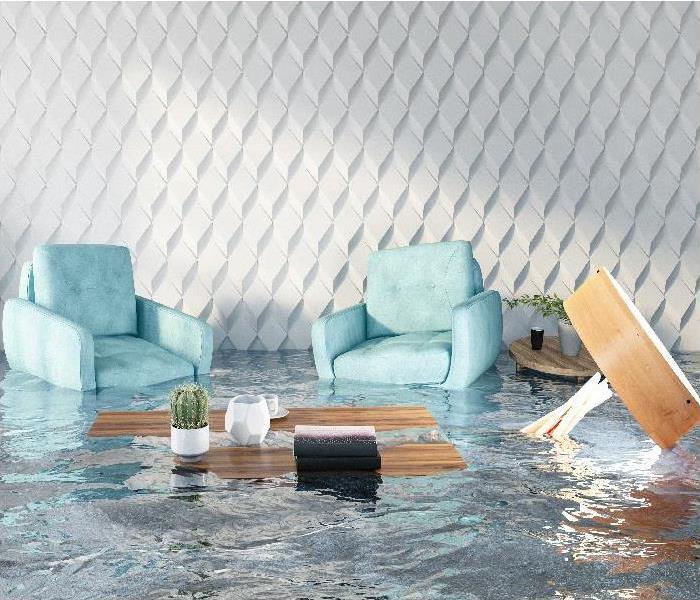What Types of Damage Can Thunderstorm in Reading Cause?
7/25/2020 (Permalink)
SERVPRO knows fast action is crucial after storms damage your Reading home
After a line of storms rolls through, there are numerous ways a Reading home can receive damage such as:
• Tree limbs damaging roofing or breaking windows
• Floodwater entering the home
• Hailstones can break windows or ruin shingles
• This type of loss requires a rapid start to the cleanup because the longer the high moisture conditions remain in the home, the greater the potential for loss.
How Does SERVPRO Handle Flood Damage and Typical Types of Storm Loss?
The certified techs want to get on-site as soon as feasible after flood damage occurs in a Reading home. The speed at which the restoration services begin has a bearing on the outcome for the property.
Preliminary efforts usually involve temporary repairs to the property, such as tarping over a damaged roof caused by high winds or boarding up a broken window from a hailstorm or a tree limb. This inhibits any further water from entering the property during the cleanup until permanent repairs can get made.
Extraction is a lot more than using a wet/dry vacuum anywhere there is water left behind within the property. SERVPRO techs approach water removal scientifically using their advanced moisture detection equipment to track the migration path of the water remaining within the structure. It is not uncommon for the technicians to arrive on-site and find little to no standing water due to the fact it has both receded and gotten absorbed within the building materials, and that is where the problems can begin such as:
• Mold
• Foul odors
• Deteriorated portions of walls and ceilings
• Delamination of tile and glue-down carpet
Through the use of their powerful extraction equipment, they can pull up the maximum amount of moisture. The techs perform the water removal phase until they get to the stage of doing "dry passes," meaning no further moisture comes up when the extractor head passes over a surface. When the water includes mud and debris, despite its unattractive name of "trash pump" these truck-mounted units can pull out copious amounts of water, dirt, and anything that came in the home with it quickly.
It is not uncommon for floodwater to contain harmful bacteria and sewage. Therefore no one in the home should come into contact with it, and if it is feasible, staying in another location until the restoration services get completed is a good idea. The techs don head to toe protective equipment to ensure the water gets handled safely and disposed of properly following local regulations for treating biohazard-level wastewater also referred to as black water.
Can Household Fans Dry a Home After Floodwater Enters?
Box fans and other consumer models do not have the airflow velocity to dry any home in the short-term successfully. The technicians have extensive training in the science of psychrometry, and that is the study of moisture and air. They know how to bring down elevated interior humidity levels rapidly and bring them below the sustainable percentages that are favorable for mold growth.
When drying a home, the techs utilize three main pieces of equipment. They use air movers to deliver warm, dry air within the structure, dehumidification units to capture any moisture remaining and port it off-site, and finally, air scrubbers to grab any airborne particles, including mold spores, and catch them in their maze of HEPA filtration to improve interior air quality.
Disinfection and Mold Prevention are Key Elements of Cleanup
After flood loss hits, the techs work diligently to return the home to a sanitary state for habitation. They remove loss items that took on the floodwater, such as carpet and upholstered furnishings. House contents such as hardwood furniture might have restoration potential if exposure to the water did not crack or damage joints. SERVPRO techs have access to a broad selection of specially formulated cleaning agents for various surfaces and applications, such as antibacterial and antimicrobial solutions.
If any remaining water odors are present, the techs may perform a final step of odor control to ensure the house does not have any musty scents left behind before any of the needed post-flood loss repairs take place. Thermal fogging is one of the most thorough ways to eradicate odors of all types through the use of a heated fog that does not introduce any moisture back into the property.
SERVPRO of Reading at (610) 779-8189 is available 24/7 to clean up flood damage in your home. No matter how large the scale of loss is, the techs work to bring your home back to its preloss condition, “Like it never even happened.”






 24/7 Emergency Service
24/7 Emergency Service
